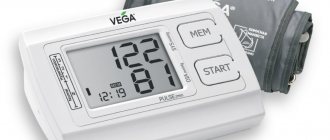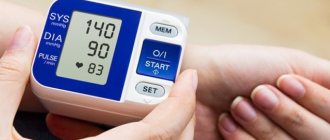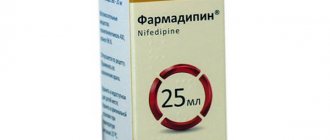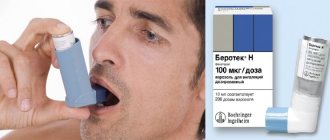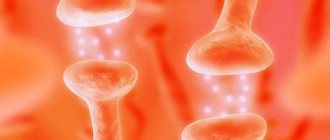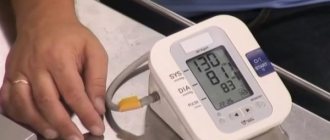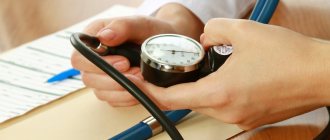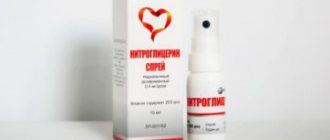ABPM - features of the procedure
ABPM is a technique that allows timely detection of blood pressure disorders in people at high risk. With the help of this examination, it is possible to take appropriate measures, adjust the therapeutic course, and prevent the development of extremely dangerous complications.
Patients suffering from cardiovascular pathologies are prone to changes in blood pressure. The reasons for a decrease or increase in blood pressure can be stressful situations, physical activity, and even the characteristics of the patient’s daily diet.
Hypertension is not diagnosed by a one-time blood pressure measurement. Information obtained in this way often turns out to be unreliable, due to various factors. The very stay of a person in the hospital is a stressful situation that contributes to an increase in blood pressure.
An examination such as 24-hour blood pressure monitoring (ABPM) makes it possible to make an accurate diagnosis.
Daily monitoring is considered an extremely informative and accurate method of diagnosis in people with diagnosed pathologies of the heart and blood vessels.
24-hour blood pressure monitoring (ABPM)
Execution technique
To carry out diagnostics, the patient visits a medical facility in the morning.
Before installing the device, it is necessary to do an electrocardiogram and measure blood pressure. If the values do not exceed the norm, then a specialist mounts the device. The cuff is fixed in the forearm area on the non-working arm in such a way that its position does not change during the entire period of the study. A mini-computer is attached to the belt, allowing you to read and write the necessary information.
The patient can also be fitted with electrodes of a Holter monitor, which allows parallel examination of the heart throughout the day.
The device operates continuously with periodic pumping of air into the cuff.
After the patient receives all the necessary recommendations, he goes home and goes about his usual activities.
What actions are needed when wearing the device?
When carrying out daily blood pressure monitoring, it is important to behave accordingly, as described by the doctor when installing the device, and to wear the device correctly. .
At the time when the next automatic blood pressure measurement occurs, the person must ensure that his muscles are in a relaxed state and his arm is located along the body.
It is important not to think that the indicators are being measured, as this may distort the validity of the results. Night sleep should also be restful. There should be no thoughts about the research process.
If the measurement began while moving, you need to stop and monitor the position of your hand.
Journaling
In addition to the fact that blood pressure is automatically measured at certain intervals throughout the day, it is also important to keep a patient diary, which records all the events performed by the patient during the day.
Experts recommend recording information regarding:
- depth and duration of sleep;
- number of awakenings;
- state of health;
- physical and emotional stress;
- eating food;
- taking medications;
- the presence of certain clinical symptoms, such as dizziness, fainting or a state foreshadowing them, pain in the heart, loss of vision, and others.
At the end of the examination, the doctor checks the monitoring data and records of complaints. This allows you to identify situations that provoke an increase in blood pressure and select the most optimal scheme of therapeutic measures.
What does ABPM show?
The ABPM device makes it possible to record minimal changes in blood pressure, displaying them graphically. ABPM results are examined by a qualified specialist. Based on the information received, the doctor makes a diagnosis for the patient and develops a therapeutic course suitable for the specific clinical case.
This examination shows:
- changes in the patient’s blood pressure during physical activity;
- working pressure, in a calm state;
- pulse pressure indicators;
- the patient's blood pressure at night.
During monitoring, it is necessary for the patient to keep a diary in which he would note all changes caused by physical activity, possible psycho-emotional shocks, times of awakening and falling asleep, and dietary habits. Thus, the interpretation of ABPM results will be extremely reliable.
Carrying out this diagnostic is a lengthy process, since specialists have to work with a large amount of data. The device is characterized by high sensitivity. ABPM data combines the following:
- changes in blood pressure during physical activity;
- pulse pressure indicators;
- a graph of blood pressure changes throughout the day;
- level of blood pressure decrease at night;
- average diastolic and systolic pressure;
- level of decrease in blood pressure in a sleepy state.
Based on the analysis of the data obtained, a final medical opinion is made regarding the interpretation of ABPM.
Example of survey results
Advantages and disadvantages of the method
The main advantage of the examination is that the ABPM device (monitor) allows you to record all changes in blood pressure within 24 hours, down to the smallest fluctuations, which is of enormous diagnostic value.
Long-term monitoring helps distinguish latent hypertension from temporary hypertension. For example, a visit to the doctor causes stress in the patient, as a result of which the blood pressure rises sharply. In a comfortable environment for a person, blood pressure is kept within normal limits.
The opposite situation often arises, when the patient reports a deterioration in health, but during a consultation with a doctor it is not possible to record critical blood pressure readings. In such a situation, the ABPM system is indispensable.
The advantages of this diagnosis also include:
- Ease of use. The compact device is practically invisible under clothing, so the patient lives as usual.
- Atraumatic. The device is fixed on the patient’s body without any intervention inside the body; it is an absolutely safe diagnostic method, and therefore is suitable for a wide audience, including children over 7 years old, teenagers, adults and the elderly.
According to doctors, the data obtained using the device is beyond doubt, and in general the technique has no shortcomings, its effectiveness has been confirmed many times, and its significance cannot be overestimated.
This study also makes it possible to timely detect an increase in the rate of morning rise in blood pressure, an extremely dangerous phenomenon that can be a trigger for the onset of stroke, myocardial infarction and even sudden death.
Feedback from the subjects themselves shows that the procedure causes minor discomfort: unusual sensations from constantly wearing a cuff on the arm, periodic squeezing of the arm when pumping air.
We bring to your attention an educational video:
Indications for examination
This procedure has the following clinical indications:
- hypotension;
- diagnosis of situational increases in blood pressure;
- identifying the degree of hypertension;
- monitoring blood pressure in women during pregnancy.
Holter monitoring can be recommended for people who have suffered strokes or heart attacks in the recent past, in order to monitor the dynamics and timely correction of the therapeutic course.
The following pathologies are relevant to the procedure:
- renal failure;
- vascular atherosclerosis;
- diabetes;
- heart failure;
- gestational disorders.
Patients suffering from these diseases are at high risk and are most susceptible to developing hypertension.
During pregnancy, examinations are carried out to monitor the health of the expectant mother. In the last trimesters, negative 24-hour blood pressure readings in the patient serve as an indication for an urgent cesarean section.
Long-term monitoring is mandatory for patients with hypertension to monitor the dynamics of the pathological process, monitor the effectiveness of the treatment, and develop the most effective therapeutic course.
Analysis of the results obtained
To develop further treatment tactics, the doctor studies the following monitoring data:
- average systolic and diastolic pressure per day;
- fluctuations in pulse blood pressure;
- increase frequency – the number of values is greater than normal;
- daily index - decrease in pressure at night.
The latter indicator, along with pulse pressure variability, is the most reliable predictor (prognostic sign) of the likelihood of developing coronary heart disease, stroke, sudden cardiac arrest, and the threat of fatal vascular accidents.
Depending on the type of graphic image obtained, the following groups of patients are distinguished:
- The daily index ranges from 10 to 19% – dippers (translated as “scoop”). The depression caused by a decrease in nighttime blood pressure resembles a bucket. Refers to a normal result.
- An index of up to 10% is an insufficient decrease in pressure during night sleep. Increased risk of heart disease, cerebral ischemia, nephropathy, and retinal damage.
- The daily index is negative, night pressure exceeds daytime pressure. Occurs in symptomatic renal hypertension. An unfavorable sign, the likelihood of heart failure and decreased renal function increases.
- An increase in the index of more than 20% is a group at high risk of heart attack and stroke in the morning.
We recommend reading the article on systolic hypertension.
From it you will learn about the pathology and the reasons for its development, symptoms of the disease, diagnosis and treatment. And here is more information about arterial hypertension and diabetes.
In order to study changes in blood pressure during normal physical activity, during sleep, and also to determine how much antihypertensive drugs prevent blood pressure surges, 24-hour monitoring is used. It is carried out using a special device; the patient must adhere to the rules of behavior during the period of blood pressure measurements and keep a self-monitoring diary.
After the data obtained, the treatment regimen is adjusted in such a way as to minimize the risks of acute vascular accidents.
When is the procedure contraindicated?
24-hour blood pressure monitoring has no absolute clinical contraindications. The examination may be temporarily postponed for the following reasons:
- skin rashes;
- period of exacerbation of dermatological diseases occurring in a chronic form;
- fractures;
- burn lesions;
- bruises, traumatic injuries.
Various injuries and violations of the integrity of the skin in the area where the cuff is installed make the examination impossible. In such cases, diagnosis is postponed until the patient’s skin has fully recovered and restored.
In case of a fracture, ABPM is not possible
Contraindications to the procedure
A safe procedure is not always prescribed by the treating specialist: the reason is poor tolerability of the study, conduction disturbances and increased systolic blood pressure (indicator more than 200). If preliminary daily blood pressure monitoring shows poor results, the procedure is not prescribed again. This type of diagnosis is contraindicated in patients with injuries to the shoulder, joints, or people with skin diseases on the forearm. Fixing the device can lead to deterioration of the skin condition (increased dermatitis).
A direct contraindication to the procedure is a decrease in platelet activity and a decrease in their number. Blood diseases during an exacerbation period are completely excluded by ABPM: other safe methods of studying blood pressure are prescribed. The technique is not used on patients with hand injuries, so as not to aggravate the condition of the upper extremities. Psychological reasons (phobias and fears) are a good reason for excluding ABPM as a procedure for a comprehensive study of blood pressure.
Preparation for the event
To obtain the most accurate and reliable ABPM results, it is necessary to properly prepare for the procedure. Patients should pay attention to the following recommendations:
- do not wear clothes that restrict or impede movement;
- normalize your schedule and daily routine;
- refrain from performing water procedures;
- avoid physical exertion and psycho-emotional shocks.
In the evening, before installing the device, you can take a sedative in order to have a good rest and recover before the examination.
If the patient is being treated with drugs, the effect of which may affect the examination results, it is necessary to report this.
When wearing the device, it is important to ensure that no moisture gets on it and the device does not fail.
Doctors provide consultations in the following clinics:
"SM-Clinic" on the street. Novocheremushkinskaya (metro station “New Cheryomushki”)
- Vyazova Natalya Lvovna
"SM-Clinic" on Volgogradsky Prospekt (metro station "Textilshchiki")
- Zabotnov Vladimir Ivanovich
- Kokin Evgeniy Andreevich
- Tikhonov Valery Grigorievich
"SM-Clinic" on the street. Yaroslavskaya (metro station "VDNH")
- Vyazova Natalya Lvovna
- Gavrish Igor Vyacheslavovich
- Pavlova Tatyana Kirillovna
- Emirova Mariyan Movlatovna
"SM-Clinic" on the street. Clara Zetkin (metro station "Voikovskaya")
- Bektaev Marat Anatolievich
- Budkova Ekaterina Vladimirovna
- Laukhina Ekaterina Anatolyevna
- Poznahareva Olga Nikolaevna
"SM-Clinic" on the street. Yartsevskaya (metro station “Molodezhnaya”)
- Bezlyudova Elena Vakumovna
- Byazrova Fariza Fidarovna
- Orlova Olesya Alexandrovna
- Toklueva Lana Ruslanovna
“SM-Clinic” in Staropetrovsky Proezd (metro station “Voikovskaya”)
- Goryunova Olga Gennadievna
- Kremnev Yuri Alekseevich
- Stepnadze Vasily Tarielovich
"SM-Clinic" in Solnechnogorsk, st. Red
- Korotkova Anastasia Alexandrovna
- Savonina Olga Alekseevna
"SM-Clinic" in Solnechnogorsk, microdistrict. Requinzo
- Korotkova Anastasia Alexandrovna
Children's clinic "SM-Doctor" on the street. Cosmonaut Volkov (metro station "Voikovskaya")
- Reidman Vitalina Rinatovna
Children's department on Volgogradsky Prospekt (Textilshchiki metro station)
- Zabotnov Vladimir Ivanovich
- Kokin Evgeniy Andreevich
- Tikhonov Valery Grigorievich
Children's department on the street. Novocheremushkinskaya (metro station “New Cheryomushki”)
- Vyazova Natalya Lvovna
Children's department on the street. Yartsevskaya (metro station “Molodezhnaya”)
- Orlova Olesya Alexandrovna
- Toklueva Lana Ruslanovna
Children's department in Solnechnogorsk, st. Red
- Korotkova Anastasia Alexandrovna
Children's department in the city of Solnechnogorsk, microdistrict. Requinzo
- Korotkova Anastasia Alexandrovna
How is the procedure performed?
The Holter examination includes an electrocardiogram and ABPM. This procedure is a round-the-clock monitoring of changes in heart rate and pulse, with fluctuations in blood pressure.
The examination is carried out as follows:
- An air-permeable cuff is placed on the patient’s arm (in the shoulder area);
- The cuff is fixed to the ABPM device;
- The device is attached using a harness to the patient’s chest;
- Blood pressure readings are measured automatically every half hour;
- The received data is recorded in the device’s memory.
The ABPM device is distinguished by a complex device that has the ability not only to measure blood pressure indicators, but to analyze them and draw up graphs. In order to get reliable results, the patient only needs to follow the following rules:
- refrain from taking medications without prior approval from your doctor;
- move freely and live according to your usual schedule;
- refrain from water procedures;
- Make sure that the tube of the device is not kinked.
It is also necessary to responsibly keep a diary, entering into it data about any physical activity or stressful situations that can provoke changes in blood pressure.
Holter study includes ABPM and electrocardiogram
What is the difference from Holter?
It is worth noting that patients often confuse ABPM with another type of hardware test - Holter monitoring (HM), which also involves wearing the device all day long.
These are different methods: Holter monitoring differs from ABPM in that it only monitors heart rate (pulse), but not changes in blood pressure. In some cases, when a patient complains of discomfort in the heart, the doctor prescribes two simultaneous procedures - ABPM and ECG (electrocardiography) according to Holter, this is called bifunctional monitoring.
Patient photos:
The results of ABPM will be useful to the patient for further examination in cardiology - echocardiography (ultrasound of the heart) and treadmill test.
Patient Instructions
The installation process of the device is painless and does not cause any discomfort to the person. The only inconvenience that the patient faces is the pressure on the arm with the cuff that occurs during the period of measuring blood pressure.
There are certain instructions, following which the patient can prevent possible ABPM errors:
- wear comfortable, loose-fitting clothes;
- do not be nervous and try to avoid stress;
- eat as usual without changing your diet;
- avoid overwork;
- refrain from using medications intended to treat hypertension.
On the day of monitoring, in order to avoid unnecessary worries and unpleasant emotions that can distort the results, the patient is recommended to avoid unnecessary contacts and, if possible, spend time at home, in a calm, relaxed state.
Life schedule is also of great importance. Going to bed should be done at a person’s usual hours. Therefore, you should also refuse to work on night shifts during monitoring or schedule an examination for another day.
“Pros” and “cons” of daily monitoring
Daily ABPM has a number of disadvantages:
- the risk of data distortion if monitoring is carried out on a “non-standard” day for the patient - a quarrel in the family, “debriefing” at work, a road accident, a broken elevator, an unexpected dinner in an exotic restaurant, etc.
- the device can disturb night sleep and cause anxiety during the day;
- Wearing the cuff around the clock causes discomfort - arm numbness, skin irritation.
However, all these nuances are insignificant. With the right approach, they can easily be negated, while the advantages of the method are undeniable. Main advantages:
- allows you to track all pressure surges and their connection with certain events;
- does not require special knowledge from the patient; the device is easy to use and almost does not interfere with everyday life;
- accessible to a wide segment of the population - both in terms of prevalence in medical practice (can be found in almost any clinic) and in price.
ABPM readings are the decisive and most reliable argument when diagnosing hypo- or hypertension.
Disadvantages of the procedure
The ABPM device is compact and invisible to others, so it can even be worn under clothing.
The disadvantages of this procedure include the following:
- Impaired sensitivity of the hand in the area where the cuff fits. Some patients complain of tension, discomfort, and increased fatigue of the limb.
- Diaper rash, skin irritation. It is observed in people with overly sensitive and delicate skin. This is due to the fact that the material from which the cuff is made does not allow air to pass through and the skin cannot breathe.
- The need to ensure that there is no compression of the tube that connects the device to the cuff. It is especially difficult to follow this rule at night. Before going to bed, a person needs to choose a certain position that does not interfere with the free flow of air into the cuff area. As a result, some patients complain of insomnia and sleep disorders.
This procedure does not cause any other side effects or unwanted reactions. During the examination, a person can carry out everyday activities and lead a normal lifestyle.
Compact device causes minimal discomfort
ABPM in childhood
ABPM can be done not only for adult patients, but also for children after seven years of age. This procedure is completely safe; it is performed on children with suspected hyper- and hypotension, with cardiac dysfunction, or with frequent fainting conditions. Often such a study is combined with ECG monitoring.
The study is carried out in exactly the same way as in adults, except that a different cuff size is selected. Before the procedure, the child needs to be told about the examination, why it is needed, and that it is painless. The cardiologist should give all the recommendations and tell you how to correctly fill out the diary during ABPM.
Important! The ABPM procedure is especially important for diagnosing vegetative-vascular dystonia. .
This pathology in children has recently happened quite often. Treatment requires accurate diagnosis, since VSD can easily be confused with arterial hypertension. The use of ABPM allows you to correctly give a medical opinion and determine the tactics of further treatment.
ABPM in children
Decoding the results
Modern ABPM devices themselves carry out the initial classification of the recorded data; pathologies are shown in tables and graphs. The doctor processes the records on a computer and this helps him make a diagnosis, choose the best treatment method and avoid possible complications.
Examination price
Daily blood pressure monitoring is prescribed to patients by a cardiologist. The price of the examination depends on factors such as the type of device used during the examination, as well as the prices of the specific clinic the patient goes to.
The average cost of ABPM is about 2300 - 2500 rubles. At the same time, in some clinics, the procedure can cost only 1200-1500 rubles, and in other, more expensive, private medical institutions - 3000 rubles.
24-hour blood pressure monitoring at MediCity
ABPM is a paid medical service everywhere.
In our clinic, this diagnostic procedure is affordable. You can sign up for it and other studies (bicycle ergometry, ECG, ECHO-KG, HOLTER) at any time convenient for you. To do this, just call our 24-hour contact center by phone.
Cardiologists and other highly qualified medical specialists at MedicCity will do everything to preserve and strengthen your health!
Is it possible to deceive ABPM?
ABPM is a procedure that diagnoses hypertension, severe heart failure and other serious pathologies that are contraindications for military service.
For this reason, young people are often interested in the possibility of distorting the results of the examination in order to avoid conscription. It is indeed possible to deceive ABPM by using methods that artificially increase blood pressure:
- 3 days before installation of the device, use tonic medications.
- Drink strong coffee drinks, black tea, or take caffeine tablets.
- Hold your breath while the cuff is installed.
- When wearing the device, lower the arm to which the device is attached as often as possible below the level of your heart. Thus, blood flow processes are disrupted, which contributes to increased blood pressure.
- While measuring blood pressure, pull up your toes and squeeze your gluteal muscles.
- Avoid sleep on the day of monitoring. This is due to the fact that when you fall asleep, your blood pressure drops by 20%.
Experts note that the above actions have an extremely negative impact on the state of the cardiovascular system!
Daily blood pressure monitoring (ABPM) is an informative diagnostic method that allows you to monitor the condition of patients with diagnosed cardiovascular pathologies and prescribe them the most effective treatment, avoiding adverse consequences and complications.
Reliability of the method
Is it possible to “deceive” ABPM so as not to serve in the army? Due to the fact that in recent years many young men, for one reason or another, do not want to serve in the army, they use many tricks to obtain a medical exemption from service. For example, many, while still in high school, begin to turn to therapists with complaints about “high blood pressure” and poor self-esteem, although this is not true. It is not difficult to increase blood pressure before seeing a doctor - physical activity (running, squats, etc.) is enough, but high blood pressure numbers in a conscript at an appointment will prompt the doctor to think about the need for further examination. In particular, about the use of ABPM.
Again, it is not difficult to achieve elevated blood pressure levels with ABPM, but it is almost impossible to deceive the doctor who performed or received the results. Firstly, this is due to the fact that many conscripts try to increase their blood pressure at night, and, as a rule, in young people, even those with hypertension, their blood pressure normalizes at night. Secondly, during exercise, the heart rate increases in proportion to the pressure, which in most cases is recorded on ECG monitoring. Therefore, the doctor, seeing sinus tachycardia coupled with increased blood pressure, will most likely think about the reliability of the technique and prescribe other research methods, perhaps even in a hospital.
Some people of military age use nicotine and caffeine-containing drinks in large quantities, and sometimes even alcohol on the day of the test. Such cocktails of caffeine and continuous exercise throughout the day will certainly affect the heart and blood vessels of a young person, and can lead to cardiovascular pathology in the future. Therefore, it is better not to take risks and carry out this examination as usual. In the end, military service is not as harmful as possible complications associated with increased blood pressure under the influence of caffeine, alcohol and excessive physical exertion, which young people unknowingly resort to in order to “dodge” the army.
There are cases when, on the contrary, the patient wants to “deceive” ABPM in order to hide hypertension and continue responsible work by passing an aptitude test. In this case, it is worth recommending that the subject, at least in general terms, reconsider his lifestyle and eliminate bad habits, such as poor nutrition and excessive consumption of salt, simple carbohydrates, animal fats and excess calories (not to mention alcohol, caffeine and nicotine). And at the same time normalize the level of physical activity, get rid of stress, lack of sleep and uneven loads. Moreover, for a good result, it is worth starting “perestroika” in advance, at least several months before the examination. And after it, “fix” a new lifestyle and improve your own health, at the same time slowing down the progression of hypertension.
